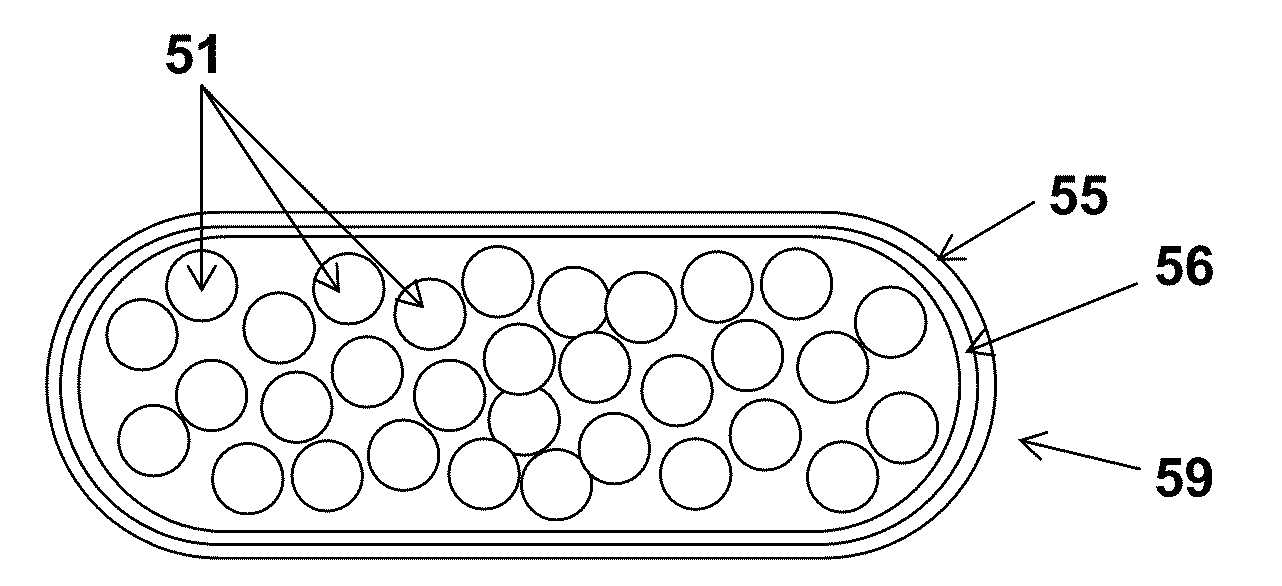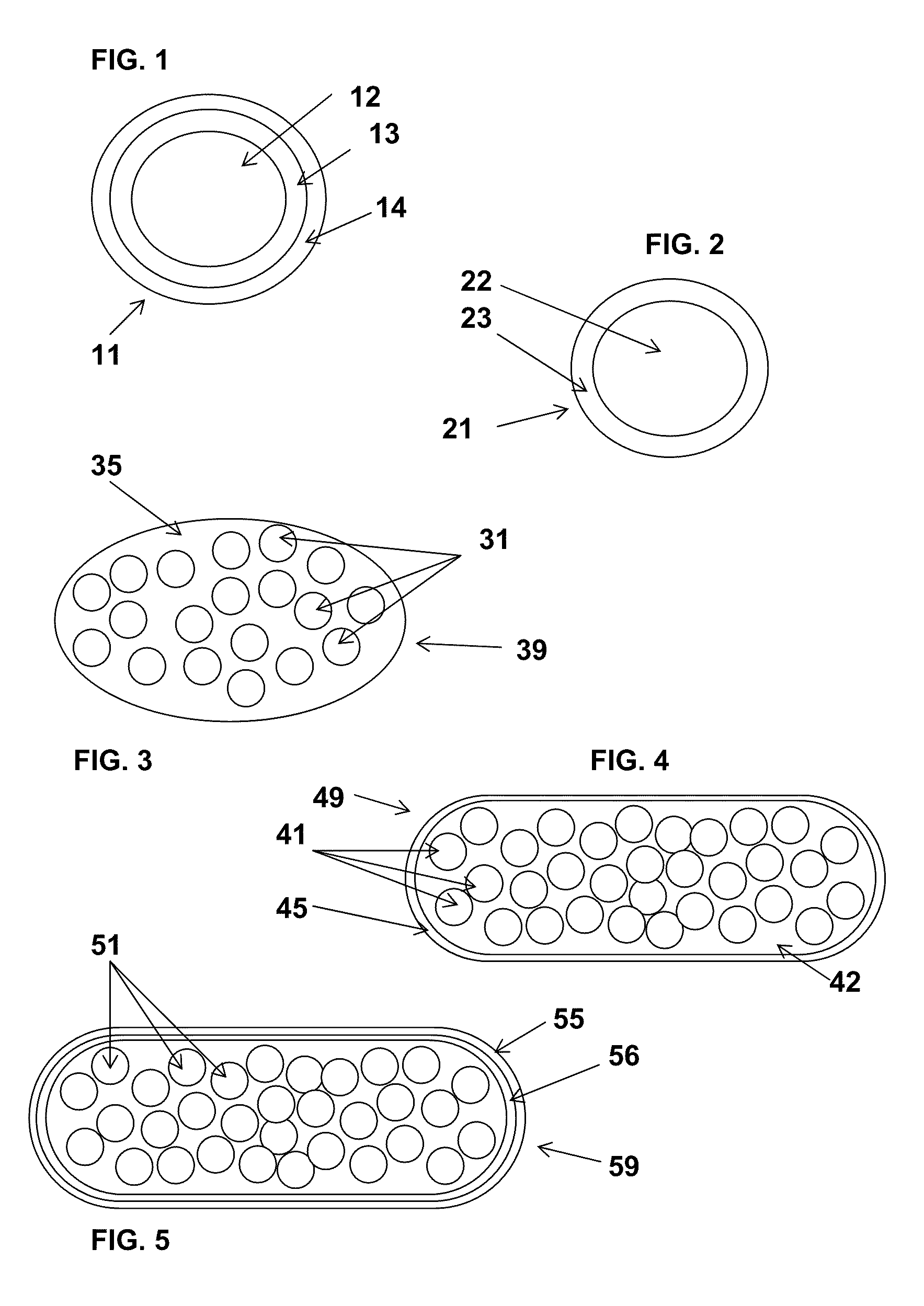Multimicroparticulate pharmaceutical forms for oral administration
a multi-microparticulate, oral administration technology, applied in the field of pharmaceutical or dietetic forms, to achieve the effect of avoiding or limiting dose dumping, reducing dose dumping, and improving efficacy
- Summary
- Abstract
- Description
- Claims
- Application Information
AI Technical Summary
Benefits of technology
Problems solved by technology
Method used
Image
Examples
example 1
Acyclovir Capsules—the Agent D is Contained in the Inert Support of the Microparticles
Step 1:
[0277]288 g of acyclovir and 72 g of hydroxypropyl cellulose (Klucel EF® / Aqualon) are dispersed in 840 g of water. The suspension is sprayed onto 240 g of guar gum (Danisco) in a fluidized air bed (Glatt GPCG1).
Step 2:
[0278]1.4 g of ethyl cellulose (Ethocel 20 Premium / Dow), 9.24 g of cellulose acetate-butyrate (CAB 171-15 / Eastman), 1.68 g of polysorbate 80 (Tween 80 / Uniqema) and 1.68 g of triethyl citrate (Morflex) are solubilized in a mixture composed of 94% of acetone and 6% of water. This solution is sprayed onto 56 g of acyclovir granules (prepared in step 1).
[0279]The microparticles obtained are then placed in a size 0 gelatin capsule (to give an acyclovir dose of 150 mg per capsule).
[0280]The profiles of dissolution D (%) as a function of time (h) in 900 ml of 0.1 N HCl and in 500 ml of an ethanol / 0.1 N HCl mixture (40 / 60 v / v), with paddle stirring at 75 rpm, are given in FIG. 6:
[0281]...
example 2
Metformin Capsule—the Agent D is Contained in the Capsule Coating
Step 1:
[0282]500 g of metformin are dispersed in 2586 g of water. The solution is sprayed onto 450 g of cellulose spheres (Asahi-Kasei) in a Glatt GPCG1.
Step 2:
[0283]228 g of ethyl cellulose (Ethocel 20 Premium / Dow), 30 g of povidone (Plasdone K29-32 / International Specialty Products Inc.), 12 g of polyoxyl-40 hydrogenated castor oil (polyoxyethylene glycerol trihydroxystearate: Cremophor RH 40 / ISP) and 30 g of castor oil are solubilized in a mixture composed of 60% of acetone and 40% of isopropanol. This solution is sprayed onto 700 g of metformin granules prepared in step 1.
[0284]The microparticles obtained are then placed in a size 2 gelatin capsule (to give a metformin dose of 150 mg per capsule). This capsule is then film-coated with a solution of sodium carboxymethyl cellulose (Blanose 7 LF / Aqualon) at a rate of 20 mg of sodium carboxymethyl cellulose per 60 mg of gelatin.
[0285]The dissolution profiles in 900 ml o...
example 3
Acyclovir Capsules—the Agent D is Contained in the Inert Support of the Microparticles and in the Capsule Constituent
Step 1:
[0287]288 g of acyclovir and 72 g of hydroxypropyl cellulose (Klucel EF® / Aqualon) are dispersed in 840 g of water. The suspension is sprayed onto 240 g of guar gum (Danisco) in a Glatt GPCG1.
Step 2:
[0288]9.84 g of ethyl cellulose (Ethocel 20 Premium / Dow), 0.24 g of povidone (Plasdone K29-32 / ISP), 0.24 g of sorbitan monooleate (Span 80 / Uniqema) and 1.68 g of castor oil (Garbit Huilerie) are solubilized in a mixture composed of 60% of acetone and 40% of isopropanol. This solution is sprayed onto 48 g of acyclovir granules (prepared in step 1).
[0289]The microparticles obtained are then placed in a size 0 vegetable capsule (based on hypromellose [or HPMC]) (to give an acyclovir dose of 150 mg per capsule).
[0290]The dissolution profiles in 900 ml of 0.1 N HCl and in 500 ml of an ethanol / 0.1 N HCl mixture (40 / 60 v / v), with paddle stirring at 75 rpm, are given in FIG....
PUM
| Property | Measurement | Unit |
|---|---|---|
| size | aaaaa | aaaaa |
| volume | aaaaa | aaaaa |
| mean diameter | aaaaa | aaaaa |
Abstract
Description
Claims
Application Information
 Login to View More
Login to View More - R&D
- Intellectual Property
- Life Sciences
- Materials
- Tech Scout
- Unparalleled Data Quality
- Higher Quality Content
- 60% Fewer Hallucinations
Browse by: Latest US Patents, China's latest patents, Technical Efficacy Thesaurus, Application Domain, Technology Topic, Popular Technical Reports.
© 2025 PatSnap. All rights reserved.Legal|Privacy policy|Modern Slavery Act Transparency Statement|Sitemap|About US| Contact US: help@patsnap.com



